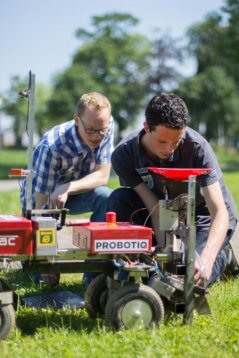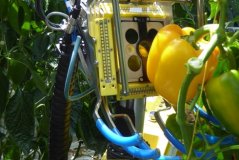
Longread
Artificial Intelligence plays a key role in understanding complex systems
WUR is investing heavily in Data Science and Artificial Intelligence (AI). In addition to current programmes focusing on Data Driven & High Tech research and the realization of Digital Twins, WUR has recently announced to use additional funding for a programme on Data Science & Artificial Intelligence.
This was hot news in July 2020. These efforts are accompanied by the arrival of the institute OnePlanet, providing integrated expertise in High Tech Sensing equipment, partnering with IMEC, Radboud University and Radboud UMC. And by the start of the Strategic Alliance with Technical University Eindhoven, Utrecht University and Utrecht UMC, which has Artificial Intelligence as one of its focal areas.
An appealing example of our current efforts to integrate AI in our domain is demonstrated by the Autonomous Greenhouse Challenge. Anna Petropoulou, researcher at the business unit Greenhouse Horticulture (PSG), tells about this challenge, her work on data sciences and AI and shares her thoughts about the future of AI.
The challenge
In the first six month of 2020, five international teams have grown cherry tomatoes remotely using their own AI algorithms. The teams were composed by experts in horticulture and AI. In the challenge the teams mainly competed against each other. In a reference greenhouse, the crop was grown by a group of Dutch growers. The growers could enter their greenhouse compartment, at least until the outbreak of COVID-19, afterwards a lot of communication took place with one of the WUR growers responsible for the greenhouse compartment. The striking outcome of this second edition of this challenge in Bleiswijk: All teams that used artificial intelligence (AI) outperformed the reference growers!
Merging two different worlds
Petropoulou was part of the organizing team and was involved in activities that were supporting teams during the real experiment (questions, technical issues), monitoring and analyzing the data that were generated during and after the completion of the project. According to Petropoulou, the Autonomous Greenhouse Challenge was a first large step in merging two different worlds. Conventional greenhouse crop growing, and data driven decision making using AI and Internet of Things (IoT).
What was fascinating is that in a short time, people of different disciplines need to communicate, collaborate and create tools that made them winners in remote and autonomous control.

“Due to the complexity of this year’s crop, the importance of product quality and the lessons learned since the first Autonomous Greenhouse Challenge, I was expecting teams to put a lot more emphasis on the growing crop. As expected this year, there were teams with more sophisticated sensing equipment that had the crop under the spotlight and tried to gather information/data on the crop’s behavior (growth and development). That allowed them to manage their climate and crop decisions successfully.” Petropoulou was not surprised that the AI driven greenhouses were winners, but she was pleased to see that the two worlds (horticulture and data experts) can co-exist and reach great results. “The outcome shows great potentials hidden in data collected in greenhouses. Even though the teams were not able to physically visit the greenhouse compartments, the data that they collected on the growing conditions were sufficient to learn their algorithms and steer their decisions optimally.”
AI projects
The business unit Greenhouse Horticulture is already working on AI on several projects. From computer vision for disease detection and for monitoring crop characteristics, to AI and robotics for harvesting, to time series data analysis for yield prediction. In the latter Anna Petropoulou is active. “We are focusing on capturing meaningful data, as it is the key element for deriving useful information to increase our understanding and the efficiency of greenhouse production systems. Sensor data plays a key role in capturing relevant climate and crop traits and is one of the main sources for AI based crop management.”
Under the Data Driven and High Tech programme Petropoulou and her research colleagues are investigating a series of new sensors and how data from these sensors can boost AI based greenhouse management. This year they also initiated the public-private-project AGROS.
With focus on developing and combining innovative sensing technologies, that can capture climate and crop traits of interest, we aim at developing intelligent algorithms for autonomous control of greenhouse production systems. This time we are one step ahead and we are not only on the organizing but on the developer’s side too.
AI as catalyst in research
Petropoulou thinks that AI can act as a catalyst for increasing and improving our understanding of complex systems using different principles in data sciences. “AI offers applications that can accelerate scientific discovery and promote significant development in technical innovation that can increase the efficiency, assist and to a certain extent replace manual activities.”
As WUR creates knowledge and expertise on food and environment, domains that are governed by complex biological organisms, according to Petropoulou AI and data sciences will enable advancements in remote sensing, autonomous control, robotics, inference and forecasting within these systems. The applications will generate large amounts of data to draw conclusions that humans may not have the capability to see otherwise.
Impact AI on society
AI is already prevalent in a normal citizens’ lives. Technologies like face recognition are in our palms, autonomous vehicles are driving on our roads and judicial authorities are making judgements purely on AI based models. Thus, a normal citizen is experiencing AI at different levels. The same will be the case for agri-food as well, in the opinion of Petropoulou. She gives some examples:
“At WUR we are using AI in animal farms for monitoring animal welfare, in precision farming to reduce unnecessary pesticide and fossil fuel use, in greenhouses for increasing yield with minimal resource use, in reducing food loss and waste in food supply chains, in giving personalized nutritional and health advise to consumers. There is no doubt that AI in agri-horti-food domain will also have a significant impact on the society (collective and personal). To feed 9.8 billion people by 2050, radical transitions in the food system are needed, and we believe AI will play a key role in that change.”

Integration of AI in practice
Representative, qualitatively and quantitatively data on different processes of the production system play a decisive role for the integration of AI in horticulture, states Petropoulou. A transparent growing history with data on climate, crop, nutrients, pest and diseases from seedling to the moment of harvest, can reveal insights from the currently separate processes.
We as humans can learn and control what we see. AI is trying to mimic what humans see but currently is hampered by the lack of data. Sensing methods need to be introduced to allow real-time, automated monitoring via sensors that will stand out in accuracy, reliability and robustness.
AI facilitates decision making
Anna Petropoulou concludes that AI, data sciences and robotics have changed the horticultural landscape already and will do in future. Automation in control and growing activities will make greenhouse production more attractive for future growers and employees in horticulture. “Greenhouses will become more advanced in monitoring and control equipment. For this transition, experts in growing will need to collaborate with experts in developing new sensing or algorithms technologies and exchange knowledge. We want to facilitate decision making and activities of end-users and secure that their requirements and needs are satisfied.”